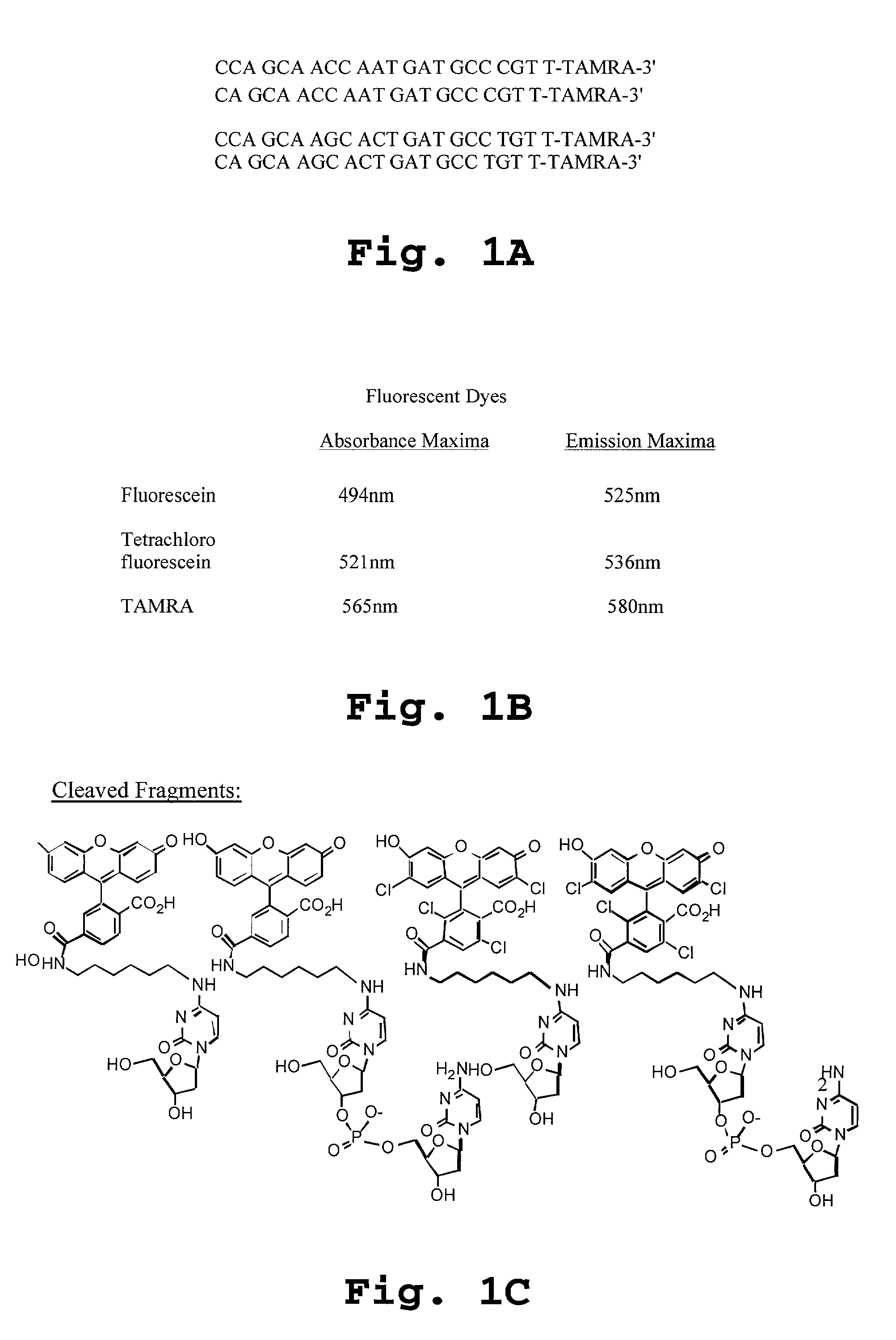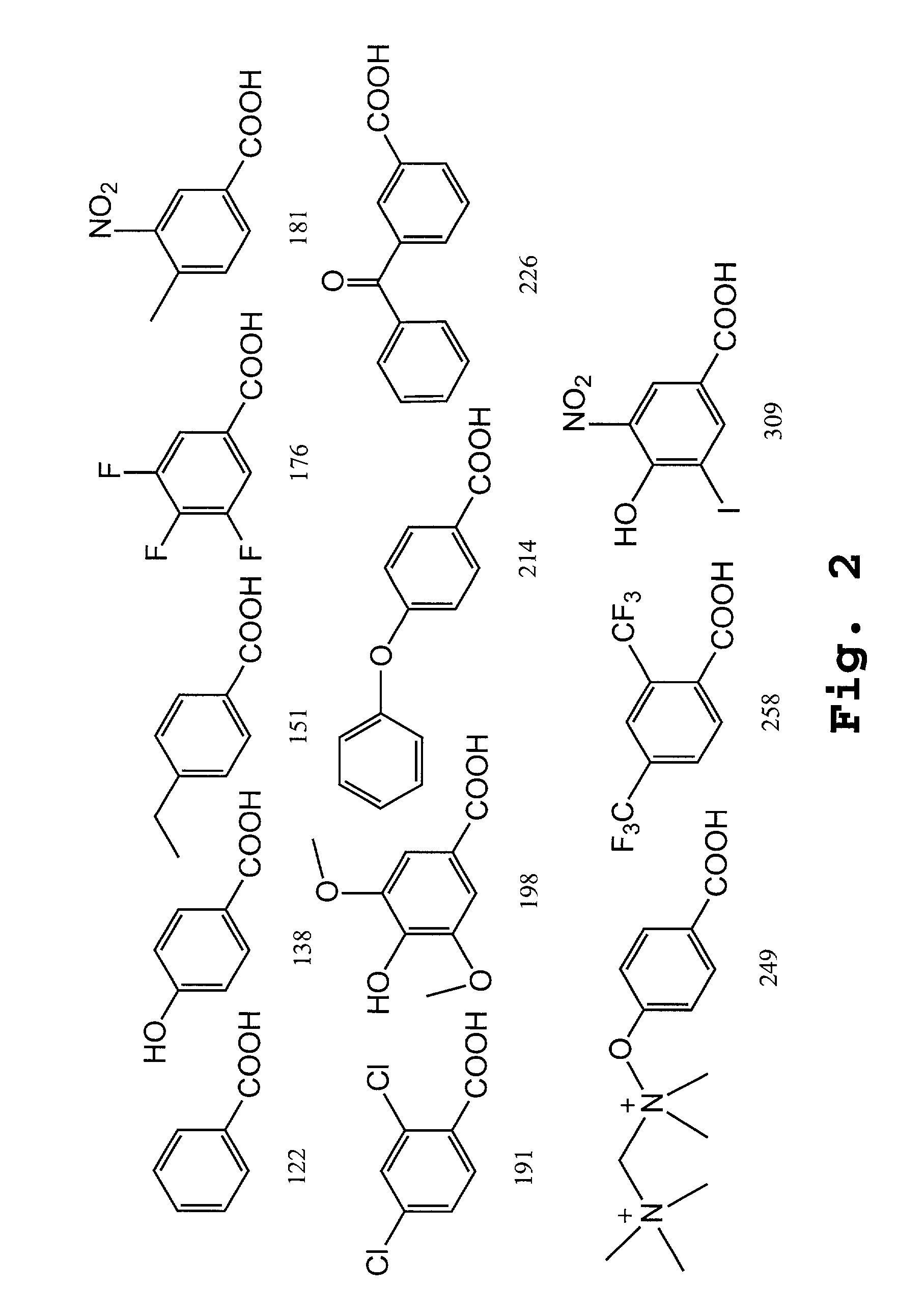Methods employing generalized target-binding e-tag probes
a technology of target-binding e-tags and probes, which is applied in the field of methods employing generalized target-binding e-tag probes, can solve the problems of high cost of arrays, confounding the accuracy of genetic information, and expensive synthesizing
- Summary
- Abstract
- Description
- Claims
- Application Information
AI Technical Summary
Problems solved by technology
Method used
Image
Examples
example 1
[0372] Singleplex Amplifications of Allele 1 and Allele 2
[0373] The experiment was set up to run in the following fashion (6 samples, a triplicate for Allele1 and another triplicate for Allele-2):
[0374] 22 .mu.L of Mastermix
[0375] 13 .mu.L of probes and primers (both the probes are present)
[0376] 4.0 .mu.L of Allele- 1 or Allele-2
[0377] 11 .mu.L of buffer (10 mM Tris-HCl, 1 mM EDTA, pH8.0)
[0378] Allele 1 was labeled with tetrachloro fluorescein (TET), and Allele 2 was labeled with fluorescein (FAM), each having characteristics as set forth in FIG. 1B.
[0379] The above volumes were added to a PCR tubes and the reaction mixtures were cycled on a Gene Amp.RTM. system 9600 thermal cycler (Perkin Elmer) as follows:
[0380] 50.degree. C.; 2 MIN (for optimal AmpErase UNG activity)
[0381] 96.degree. C.; 10 MIN (required to activate AmpliTaq Gold DNA Polymerase)
[0382] 40 cycles of:
[0383] 95.degree. C.; 15 SEC
[0384] 60.degree. C.; 60 SEC
[0385] 70.degree. C.; 10 MIN
[0386] 4.degree. C.; storage
[038...
example 2
[0388] A multiplexed reaction with both Allele 1 and Allele 2 present in equal ratio
[0389] The experiment was set up in the following fashion (3 reaction tubes, a triplicate):
[0390] 22 .mu.L of Mastermix
[0391] 13 .mu.L of probes and primers (both of the probes were present)
[0392] b 4.0 .mu.L of Allele-1
[0393] 4.0 .mu.L of Allele-2
[0394] 7 .mu.L of buffer (10 mM Tris-HC, 1 mM EDTA, pH 8.0)
[0395] The above volumes were added to a PCR tubes and the reaction mixtures were cycled on a Gene Amp.RTM. system 9600 thermal cycler (Perkin Elmer) as follows:
[0396] 50.degree. C.; 2 MIN (for optimal AmpErase UNG activity)
[0397] 96.degree. C.; 10 MIN (required to activate AmpliTaq Gold DNA Polymerase)
[0398] 40 cycles of:
[0399] 95.degree. C.; 15 SEC
[0400] 60.degree. C.; 60 SEC
[0401] 70.degree. C.; 10 MIN
[0402] 4.degree. C.; storage
[0403] The results are shown in FIG. 20: CE separation of a 1:1 mixture of the 40 cycles products of Alleles 1 and 2. Experimental conditions were as given above for the ...
example 3
[0404] A multiplexed reaction with both Allele 1 and Allele 2, where Allele 1 is 10 times more concentrated than Allele 2
[0405] The experiment was set up in the following fashion (3 reaction tubes, a triplicate):
[0406] 22 .mu.L of Mastermix
[0407] 13 .mu.L of probes and primers (both the probes were present)
[0408] 5.0 .mu.L of Allele 1
[0409] 0.5 .mu.L of Allele 2
[0410] 9.5 .mu.L of buffer (10 mM Tris-HCl, 11 mM EDTA, pH 8.0)
[0411] The above volumes were added to a PCR tubes and the reaction mixtures were cycled on a Gene Amp.RTM. system 9600 thermal cycler (Perkin Elmer) as follows:
[0412] 50.degree. C.; 2 MIN (for optimal AmpErase UNG activity)
[0413] 96 C; 10 MIN (required to activate AmpliTaq Gold DNA Polymerase)
[0414] 40 cycles of:
[0415] 95.degree. C.; 15 SEC
[0416] 60.degree. C.; 60 SEC
[0417] 70 C; 10 MIN
[0418] 4 C; storage
[0419] The results are shown in FIG. 21: CE separation of a 1:10 mixture of the 40 cycles products of Alleles I and 2. Experimental conditions were as given for ...
PUM
| Property | Measurement | Unit |
|---|---|---|
| charge/mass ratio | aaaaa | aaaaa |
| charge/mass ratio | aaaaa | aaaaa |
| temperature | aaaaa | aaaaa |
Abstract
Description
Claims
Application Information
 Login to View More
Login to View More - R&D
- Intellectual Property
- Life Sciences
- Materials
- Tech Scout
- Unparalleled Data Quality
- Higher Quality Content
- 60% Fewer Hallucinations
Browse by: Latest US Patents, China's latest patents, Technical Efficacy Thesaurus, Application Domain, Technology Topic, Popular Technical Reports.
© 2025 PatSnap. All rights reserved.Legal|Privacy policy|Modern Slavery Act Transparency Statement|Sitemap|About US| Contact US: help@patsnap.com



